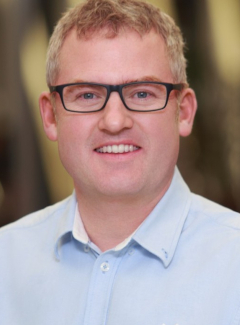European Steelmakers Forced to Adapt to Soaring Costs and Shifting Trade Dynamics
_1.jpg)
By Amy McLellan
Green steel may be facing a storm of soaring costs and shifting trade dynamics, but despite the uncertainty, industry leaders remain bullish that green hydrogen and low-carbon steel will be a winning combination in Europe's race to net zero.
From Issue 3, 2025 of Breakbulk Magazine.
(5-minute read)
The month of April 2025 is likely to be one of those months that, for years to come, marks a spot on a graph where something monumental happened. Following President Trump’s “Liberation Day” announcement, which imposed a suite of tariffs on countries ranging from China and Vietnam to Lesotho and Vanuatu, trillions of dollars were wiped off the value of stock markets, the price of oil dropped sharply and factories began to lay off workers.
Whether this is a watershed for a new economic order or a short-lived shock remains to be seen, but it has underscored how interconnected the global economy is – and how little scope there is to absorb such shocks.
Steelmakers find themselves on the frontline. This is not unusual for a key strategic industry, but the trade row could not have come at a worse time for European steelmakers, with some plants already teetering on the edge.
At the end of March, for example, British Steel’s Scunthorpe steelworks was in emergency talks to find some way to stave off closure this summer. Since 2020, the plant has been owned by Chinese group Jingye, which says it has invested more than £1.2 billion into the plant and claims the financial losses are running at around £700,000 a day.
The backdrop to this crisis includes intense pressure from global overcapacity, rising exports from China and increasing trade barriers in key markets like the U.S. Global excess capacity was estimated at 602Mt in 2024 and is forecasted to reach 721Mt by 2027 – this is more than 100 times the UK’s production.
Capacity expansions in Southeast Asia and the Middle East are mostly state-funded and involve high-emission blast furnaces. And as steel demand weakens in key markets, such as China, there’s more steel available for export to other markets, further depressing prices at a time sustainability targets are piling on costs. As the UK’s newly-formed Steel Council points out, over two-thirds of steelmaking capacity is in countries that have net-zero targets later than 2060 - or none at all.
Producers in the UK and continental Europe, facing looming decarbonization targets over the coming decades, have been struggling to transition their largely coal-based blast furnaces to cleaner technology. A key sticking point in talks to save British Steel’s Scunthorpe steelworks is Jingye’s claim that the government’s financial support for a transition to a 100% electric arc furnace (EAF) has fallen short of expectations.
The Hydrogen Hype
Steelmaking is one of the most emissions-intensive sectors, and also one of the hardest to abate. Green hydrogen, made using renewable energy, has been tipped as a solution but it’s both expensive and challenging to scale. Indeed, the hype around green hydrogen has proved slow to convert into viable commercial-scale projects.
Recent announcements from ArcelorMittal and thyssenkrupp, made before Liberation Day, raise more doubts about some of the promising green steel projects in Europe.
German steelmaker thyssenkrupp Steel, for example, has suspended a tender for the purchase of green hydrogen for its direct reduction plant in Duisburg, citing high costs. The plant will still go ahead, but will run on natural gas instead. Natural gas still offers a 50% reduction in carbon emissions compared to conventional blast furnaces but it’s a long way from the emissions-free promise of a hydrogen plant.
Meanwhile, ArcelorMittal has put the brakes on its plans to invest in “hydrogen ready” DRI-EAF facilities, pending government funding support.
“Green hydrogen is evolving very slowly towards being a viable fuel source,” the company said in a statement, also citing concerns about the regulatory regime and trade protection measures. “Before taking final investment decisions it is necessary to have full visibility on the policy environment that will ensure higher cost steelmaking can be competitive in Europe without a global carbon price.”
The Luxembourg-based group continues to invest in electric arc furnaces, which can also be fed with scrap steel to significantly reduce emissions and contribute to the circular economy. It is also investing in carbon capture utilization and storage (CCUS) to help meet its decarbonization goals, although like green hydrogen, this technology is likely to only make a meaningful difference after 2030.
Announcing the delays, chief executive Aditya Mittal said the regulatory environment required to support the business case for investments is not yet in place. Nor it seems is the customer appetite – certainly not at current prices.
“While we do have customers that want low-carbon steel, those that do and are willing to pay a premium are still very much in the minority,” said Mittal.
Long Term Outlook
 Even so, many analysts remain optimistic that green hydrogen and green steel are a winning combination in a net-zero world. Indeed, Alistair Ramsay, vice president of metals and materials at Rystad Energy, says the outlook for green hydrogen as a technology to decarbonize steelmaking remains strong.
Even so, many analysts remain optimistic that green hydrogen and green steel are a winning combination in a net-zero world. Indeed, Alistair Ramsay, vice president of metals and materials at Rystad Energy, says the outlook for green hydrogen as a technology to decarbonize steelmaking remains strong.
“It is the optimal way to reduce unit emissions significantly (>90%) in this hard-to-abate sector and as demand for steel is on course to increase in the future with a rising population, more modest decarbonization technologies may struggle even to reduce, never mind solve the problem,” says Ramsay. “This value, however, comes at a premium, which potential steelmakers struggle to justify to their potential clients as it does not improve the capabilities of the steel in real applications.”
He doesn’t believe the technology is over-hyped, however, and that longer term it will make an impact - as long as decarbonization remains a long-term priority.
“We feel the new U.S. tariffs, which are far broader and deeper than during President Trump’s first term, will add to the negative but largely short-term impacts on steel decarbonization by restricting the profits and investment potential of the steel supply chain,” he adds.
“Even in the event that such tariffs were to endure into next year and beyond, however, their effects would be increasingly inconsequential. As exporters to U.S. markets divert supplies elsewhere, such as the EU, they are likely to find carbon taxes rather than import tariffs and will be encouraged to decarbonize.”
Safety and Regulation
It’s not just that green hydrogen is expensive; it’s still a technology that needs to climb a maturity curve, says Magnus Killingland, global segment lead for hydrogen, ammonia and sustainable fuels at DNV.
He notes that even the most experienced hydrogen producers and users, such as oil and gas refiners and ammonia/fertilizer producers, are still testing medium to large electrolyzers, before planning to scale further. “When they are careful and want to update standards and establish new best practices, the rest of the industry pays close attention,” says Killingland.
DNV doesn’t expect hydrogen to take off until some key pilot projects have gained real operational experience, such as Shell’s 200 MW Holland 1, the first phase of NEOM in Saudi Arabia, which will produce green ammonia for shipping and industrial applications, and BP’s 100MW Lingen refinery in Germany.
The stop-start progression has dented hopes among the project cargo sector that a boom in the build-out of green hydrogen hubs and green steel facilities might open up a new market. Hydrogen reduction reactors, electrolysis units, EAF transformers, hydrogen storage tanks and carbon capture systems are all oversized industrial components that demand specialized transport, heavy-lift capabilities and precise logistics coordination.
Given recent volatility, however, it’s likely some anticipated FIDs for 2025 may be held back, pending more certain times.
The impact of tariffs on global trade will be a key talking point in a panel session at Breakbulk Europe 2025. “Ask the Experts: Tariffs, Trade, and What Comes Next” will take place on the main stage at Rotterdam Ahoy on Wednesday, 14 May from 3:30pm – 4:15pm.
Photo credit: Shutterstock
